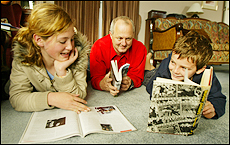| Damaged
for life by too much TV
Saturday July 17, 2004 |
|
Saturday July 17, 2004
|

17.07.2004
By MONIQUE DEVEREUX
Watching too much television as a child causes serious health problems years later, and raises the risk of heart disease, a New Zealand study of 1000 children has found.
And researchers say the health problems will be far greater for the next generation, as children now have access to far more TV and other electronic media than they did when the research began.
The Otago University researchers want the Government to consider banning advertising - particularly for fast food - during the hours children are more likely to be watching.
The study is the first of its kind in the world and will be published today in the international medical journal The Lancet.
It links the amount of time spent in front of the box as a child with obesity, high cholesterol, poor fitness and smoking.
The researchers followed about 1000 children born in Dunedin in 1972 and 1973.
Every two years between the ages of 5 and 15, they were asked how much television they watched.
Those who watched the most also had the most health problems as young adults.
This week, the Royal Australasian College of Physicians issued the results of research into the effects of electronic media on children. It said too much television could interfere with children's growth and development.
Those findings were drawn from a review of 148 papers written on American, Australian and New Zealand child health.
But the Dunedin Multidisciplinary Health and Development Research Unit study has looked specifically at television watching and its effects on health.
The children in this study watched TV for 2 hours 20 minutes a day, exceeding US health guidelines of no more than two hours.
Among all 26-year-olds, 17 per cent of those who are overweight, 15 per cent of those with high cholesterol, 17 per cent of smokers and 15 per cent with poor fitness could be directly attributed to watching more than two hours of TV a day.
Only 7 per cent of those in the study watched less than one hour a day as children, and they were by far the healthiest.
Study head Dr Bob Hancox said the Dunedin subjects grew up in the 1970s and 80s when New Zealand had only two television channels and most homes had only one TV set.
Today, children have access to scores of satellite channels, games, videos, DVD and the internet.
The health effects of television viewing could not be explained by any other factors, such as family habits or socio-economic status.
"It's not just that children who were already overweight decided to watch more television," Dr Hancox said.
"Rather, children who watched a lot of television were likely to become overweight.
"If we really want to do anything about the obesity epidemic, we have to make some hard choices like reducing the amount of TV kids watch."
Restricting junk-food advertising and children's ability to buy it were last year canvassed in submissions on the new Public Health Bill, which the Government is due to release soon.
Dr Hancox said parents could make a difference by turning the TV off more often, but to really address the obesity problem society had to have a change of mindset.
"Individual parents have got a big role to play, but I think it's too much to expect parents to do everything themselves.
"There is a lot of pressure for kids to watch TV from their friends at school, but I think society and parents really need to think about how we can reduce it.
"We should all be watching less TV."
Soap operas, cartoons rule
Soaps and cartoons are the staple viewing diet for young viewers, according to ACNielson ratings.
TV2's Shortland St was the most popular weekday show for 5 to 14-year-olds between July 6 and July 13. The soap scored an average rating of 13 per cent of the potential audience in that group. Its average audience share (percentage of those in the age group watching television at that time) was 37 per cent.
Next come TV3's The Simpsons (rating 11 per cent, audience share 32 per cent) and morning cartoons, Clifford the Big Red Dog (9 per cent and 52 per cent) on TV2 and Caillou (8 per cent and 45 per cent) on TV3.
Weekend mornings are ruled by What Now (11 per cent and 59 per cent) on TV2 and TV3's The Wild Thornberrys (10 per cent and 49 per cent). Friday and Sunday are the most popular viewing nights, when Celebrity Treasure Island attracts the largest rating of the week for 5 to 14-year-olds - 25 per cent - and a 68 per cent audience share.
One News and 3 News both attracted an average rating of 6 per cent, although TV3's average audience share was 2 per cent higher at 23 per cent.
http://www.nzherald.co.nz/storydisplay.cfm?storyID=3578876&thesection=news&thesubsection=general